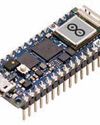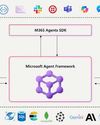GitOps: A Strategic Comparison of FluxCD and ArgoCD
Open Source For You
|September 2025
In a world where agility and resilience are essential, embracing GitOps isn’t just a smart move it’s a transformative step towards future-ready DevOps. Explore what GitOps means, and how to choose between FluxCD and ArgoCD two tools designed to help automate Kubernetes deployments directly from Git repositories.

In the ever-evolving world of DevOps, GitOps has emerged as a fresh and powerful approach to managing infrastructure and deployments.
Imagine managing your entire cloud environment - from server configurations to application rollouts - just by pushing code to Git. That's the promise of GitOps.
Two open source champions of this practice are FluxCD and ArgoCD, tools designed to help automate Kubernetes deployments directly from Git repositories. While they share a common goal, their unique capabilities and philosophies cater to different needs.
Let's start with the basics. GitOps is a set of practices that uses Git repositories as the source of truth for declarative infrastructure and application code. Instead of manually configuring environments or deploying via traditional CI/CD pipelines, GitOps agents ensure your cluster matches what's in your Git repository, automatically.
Key principles of GitOps are:
Single source of truth: Git stores your infrastructure and app definitions. No more guessing what's deployed where.
Declarative configuration: You describe what the system should look like. The GitOps tool ensures it matches the real state.
Automated reconciliation: If someone accidentally changes something in the cluster, GitOps corrects it.
Auditability and rollbacks: Git's version history provides transparency and easy rollback options.
Think of GitOps like a thermostat. You set your desired temperature (your infrastructure state) and the system keeps adjusting until it matches your configuration. If the room gets too cold, the heat kicks in; if something in your cluster diverges, GitOps agents bring it back in line.
GitOps in action: Typical workflow
Here's a basic workflow to help visualise how GitOps fits into DevOps teams.
यह कहानी Open Source For You के September 2025 संस्करण से ली गई है।
हजारों चुनिंदा प्रीमियम कहानियों और 10,000 से अधिक पत्रिकाओं और समाचार पत्रों तक पहुंचने के लिए मैगज़्टर गोल्ड की सदस्यता लें।
क्या आप पहले से ही ग्राहक हैं? साइन इन करें
Open Source For You से और कहानियाँ

Open Source For You
The Role of Open Source in Building Modern Data Infrastructure
It's no secret that open source is emerging as the backbone of modern data infrastructure. Here’s a list of the core open source technologies used to deploy this infrastructure, along with some real-world examples and a brief on why open source matters.
3 mins
December 2025

Open Source For You
The Whispering Machines: How Open Source is Bringing Intelligence to the Tiniest Devices
Built on open source frameworks, TinyML is enabling complex machine learning models to run on the microcontrollers embedded in connected devices, bringing artificial intelligence to the very edge of the network.
3 mins
December 2025

Open Source For You
Setting Up Snort to Secure Your Network
Snort is a popular, open source intrusion detection system that monitors traffic in real time to detect malware. Here’s a detailed explanation of how to set it up on Ubuntu and test it by generating traffic from another system.
7 mins
December 2025

Open Source For You
When AI Meets DevOps to Build Self-Healing Systems
Traditional DevOps, with its rule-based automation, is struggling to work effectively in today’s complex tech world. But when combined with AlOps, it can lead to IT systems that predict failures and solve issues without human intervention.
7 mins
December 2025

Open Source For You
How to Automate Java Code Modernisation
This short guide illustrates that automating Java code modernisation with Python and OpenAI API is not just possible-it's remarkably effective.
5 mins
December 2025

Open Source For You
The Quest to Build a Quantum Computer
The road to large-scale quantum computing is long and hard, with incremental advances paving the way. But the destination is in sight.
12 mins
December 2025

Open Source For You
Job Opportunities: What's Hot in the Cloud Space?
If there's one field that refuses to slow down, it's cloud computing. Even as automation and AI reshape roles, cloud adoption continues to surge. From startups deploying microservices overnight to enterprises migrating decades of legacy systems, cloud remains the engine of digital transformation. For professionals, this means one thing: skills that live in the cloud won't come down anytime soon.
2 mins
December 2025

Open Source For You
Securing Client Identity with Post-Quantum Cryptography
Here's a quick tutorial on how to build a secure, real world client-server model that establishes client identity by using CRYSTALS-Dilithium, a post-quantum cryptography algorithm.
3 mins
December 2025

Open Source For You
Unlocking the Power of Multi-Agent Solutions with the Microsoft Agentic Framework
The Microsoft Agentic Framework is rapidly emerging as a cornerstone for developers, architects, and technology leaders seeking to build dynamic, intelligent systems powered by multiple collaborating agents. In an era where automation, distributed intelligence, and adaptive software are increasingly vital, this framework offers robust tools and features to accelerate the design and deployment of agent-based solutions.
6 mins
December 2025

Open Source For You
Apache Iceberg and Trino: Powering Data Lakehouse Architecture
Apache Iceberg is a cornerstone of any open data lakehouse, providing the transactional foundation upon which highly scalable and flexible analytics can flourish. Along with Trino, it can be used to build a robust, scalable, and high-performance data lakehouse.
4 mins
December 2025
Listen
Translate
Change font size

